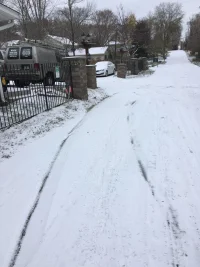I think that given where you live, A/S are the most economical answer, since outlay of cash is a definite limitation for you. A/S will handle anything the Lower Forty-Eight have to dish out. The A/S UHP tire (like the Nitto Motivo I run in the winter) is the best all around performer in the winter where you live: it almost never freezes, and even then it is not days on end, resulting in frozen pavement. When the weather rises above freezing every day, and then snaps down to freezing day and night for a couple of days, the road surface remains warmer than the air because of the residual heat buildup over those many days above freezing. NC is not a place where you can even use a winter tire setup without stressing the compound in non winter conditions too often to make winter tires economically viable. Here, in Utah, we have cold weather where the day time temperatures don't get above freezing, sure we do: but those periods are brief (except in the most rare, extreme circumstances: I am speaking about driving in the valleys, not the upper elevations): and typically our roads are clear and dry well over 90% of the time; with daytime temps rising above freezing, even typically into the 40s for days or weeks on end. We get a few to half a dozen significant snow drops. Clearly, the winter tire shines at those times. The rest of the time, the 90%, the A/S tire outperforms the winter tire around here. In NC, winter is not even half what it is here. So the A/S makes even more sense for you.
Stopping on ice isn't a consideration, since a snow tire won't save you if the first instant you're aware that you're on ice is when the skid with locked wheels starts. Oh, you might stop in twenty feet while an A/S will take less than twice that: if we're talking really slow, cautious speeds. If you're maintaining distances, either stopping distance should be enough. But if you're at highway speeds and hit black ice, just pray: no tire is going to swing the difference and save you: when that happens you're just a witless passenger.
When you get to Up State NY, if it is winter, the weather is going to be your first clue. Temperatures below freezing are not going to affect an A/S dramatically. Snow on the road means slow down, establish extra distance. If you did have a winter tire, you might get a false sense of security. I would drive the same on both tires.
If you did the drive on your Michelin summer tires, you wouldn't be in really dicey gription circumstances on a dry road until the temperatures dropped below c. 20F. Below c. 40F summer tires start to degrade in gription, true: but you just drive with more reserve, as if the tires are not expected to perform up to their intended potential: which is the truth. In the event that snow/slush/ice is on the road, you would crawl if you know what's required of you. And curse your luck! And hope to get out of it as soon as possible, however possible. Hard Michelin summer tires are a catastrophe waiting to happen. I have driven on mine at c. 32F more than once (just yesterday, in fact), at highway speeds, on mountain curves, on wet pavement even running to slush, and had no issues. But the tires were already warmed up when I got to those elevations and conditions, and I didn't push them. You just have to appreciate your limitations and stay well within them.




